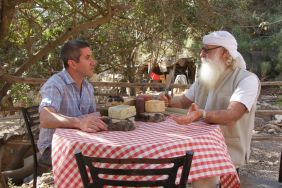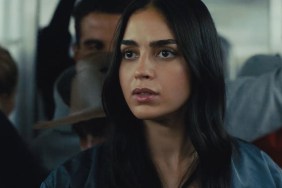In the 15 years since he transitioned from painter to filmmaker, New York artist Julian Schnabel has tackled a number of true-life stories from his first film based on friend and peer, New York street artist Jean-Paul Basquiat, to his portrait of Cuban writer Reinaldo Arenas in Before Night Falls and quadriplegic Elle editor Jean-Dominique Bauby in The Diving Bell and the Butterfly, for which Schnabel was nominated for an Oscar.
His fifth film Miral is no less of a true story even if the names have been changed, as it’s based on a novel by author and screenwriter Rula Jebreal that’s mostly autobiographical. Slumdog Millionaire star Freida Pinto plays the title character, an Arab girl born into adversity as her alcoholic mother commits suicide forcing her father to put her in a school for orphans. As a teenager, Miral is given a crash course in the political climate of her country when she falls for a young Arab man who happens to be involved in the Palestinian rebellion. Schnabel’s latest is just as much about Hind Husseini, played by Hiam Abbass, an Arab woman who took in thousands of young orphaned children left homeless by the war between the Israeli army and the country’s Palestinian population to create a self-funded school, making Hind a primary influence on Miral and on Rula. The cast for Schnabel’s Mid-East tale is rounded out with two of the finest Arab actors in Alexander Siddig and Omar Metwally.
It’s a film that has created a surprising amount of controversy in the Jewish community, most recently when the American Jewish Committee (AJC) tried to get the President of the United Nations General Assembly to cancel the premiere of Schnabel’s film at the UN, claiming it was “anti-Israel.” Anyone who has seen the movie in its entirety will realize that’s not the case at all.
Last week, ComingSoon.net was invited to Julian Schnabel’s Palazzo Chupi, a former horse stable in the West Village that he had converted into residential condominiums that are hard to miss while walking in the neighborhood, possibly being the only pink building in the area. Schnabel’s own loft was absolutely amazing with every wall covered with some of his large floor-to-ceiling paintings. Fully aware of Schnabel’s eclectic reputation, we were quite nervous as we were escorted into his enormous bedroom which was also filled with artwork including a mosaic tile-covered table on which was resting some sort of large animal skull.
After offering us our choice of chairs to sit in, Schnabel sat back in his own comfy red chair in his trademark pajamas and slippers, noshing on a toasted bagel with cream cheese while answering our questions and eventually kicking his slippers off as the discussion got more serious.
Working within a world where creating the most populist and mainstream fare is applauded–insert The King’s Speech joke here–Schnabel is really one of a kind, an artist who does what he wants how and when he wants to do it, which just makes him that much more interesting as someone to talk to about his craft.
ComingSoon.net: I don’t get the impression you’re someone who spends hours going over screenplays trying to figure out what is going to be your next movie.
Julian Schnabel: That’s true.
CS: You had a pretty big break between “Before Night Falls” and “Diving Bell” so when you first met Rula and heard about her book, was it an immediate thing that you knew you wanted to make the movie? How long did it take you to decide?
Schnabel: She asked me to read a script that somebody wrote. I was having a show of paintings at the Palace Venezia in Rome, and I said, “Don’t expect anything, I probably won’t like it, because I only do my own work but I’ll read it.” When I read the script–she didn’t write it, somebody else had written the script–and I said, “The script isn’t very interesting but it looks like the book is interesting, can I read your book?” This was not in person, this was over the telephone, and she sent me a very rough translation of the book and I thought, “Now THAT’s a movie,” and as a Jewish person I thought that was something that I need to come out to understand, and that’s my responsibility in a way to address this. What happens in the Mid-East, what happens in Israel and how it affects all of us everywhere, we need to solve that. I thought that if I could do that in an artistic way, in a poetic way that can address that, that might make people empathize more, then it was worth it. So that was it.

I mean, I don’t look at scripts all the time. I wanted to make “Perfume” (based on the 1985 bestselling novel by Patrick Süskind, which was adapted later by Tom Tykwer) after I made “Before Night Falls” and I wrote a script to it, but I ended up making “The Diving Bell and the Butterfly” because life happened to me. My father was sick, I used to talk to Fred Hughes who was paralyzed and stuck inside of his body and his nurse Darren gave me this book, and I could transpose some of the things that were happening to Jean-Baptiste Grenouille, who was traveling with his olfactory sense to Jean-Do, who was traveling in his imagination, so I kind of combined those things and made that movie.
CS: Had you seen any of the other movies about the Palestine situation in Israel; I would warrant a guess that “Paradise Now” was one of the better ones…
Schnabel: Excellent movie.
CS: Was this topic something that you’d been interested in over the last 20 or 30 years or was it something that became more interesting recently to you?
Schnabel: I didn’t pay too much attention for years. In 1987, I had a show of paintings in the Israel Museum in Jerusalem, and I really didn’t know anything about it. In fact, I resisted. After my Bar Mitzvah, my mother was saying, “Go to Israel, have that special feeling.” I didn’t want to do that. I went surfing and I went out West, I went in a different direction. My religion was painting, it wasn’t organized religion, but as I grew up, I made “The Diving Bell and the Butterfly” for my father, but I made this movie for my mother. I think I owed it to her. I mean, she was President of Hadassah in 1948–she was President of Hadassah many different years–but the first President in Brooklyn.
CS: I also have a Jewish background and my mother has always been involved with the temple, but when I went to Hebrew school back in (REDACTED), Israel was talked about a lot, but you rarely hear about the Palestinians and the conflict. You hear about the formation of the state, and it’s only been the last ten or fifteen years where we really are hearing a lot more from the other side.
Schnabel: When (Israeli President David) Ben-Gurion said, “We’re a people without a country, here’s a country without a people,” that was not true. There were people there, and we have to live with them and take care of them. It’s good for our soul.
CS: When you watch the movie and you get to the end, it’s obvious that you made it to promote peace, but there’s been a bit of controversy lately in that a certain Jewish organization didn’t want anything to do with it at all, because they feel it’s pro-Palestine.
Schnabel: But it’s not true. The government might say something or the AJC might say they don’t want to see it, but there’s other Jewish groups that came out and supported (the movie) right after that happened, and Bianca has the name of them, and there’s a Rabbi sitting on the stage and another Jewish man who was a fighter pilot for Center for Non-Violent Solutions talking about what is really going on over there, and this is exactly what I wanted. The more people that see the movie, the more dialogue. I want people to care about those characters and I think they do, and I think that’s why I’m hearing “Why do I care about these characters? How can you hate a little girl that’s in school, why should you hate her?” It’s easier to hate a guy with a Kalashnikov and a beard. You asked me about different movies before, but there are other movies like “Pixote” by Hector Babenco about kids in Brazil or “In This World” by Michael Winterbottom about these people in Afghanistan. Wherever people are struggling, there are stories that need to be heard. We’re part of the global community, and I think that there shouldn’t be a ban on a story about Palestinian people. I saw some incredible documentaries like “The Children of Arna,” have you seen that? You should watch that. It shows a Jewish woman who started a theatre school in Jenin. Out of the ten kids in the play you see, in real life, six died as suicide bombers, two of them are in jail and two of them survived out of ten. There’s another movie you should see, “Jenin Jenin,” another documentary made by Palestinian and Israelis, “The Iron Wall.”

CS: You’ve dealt with the topic of conflict and war in some of your artwork, but making a film is a lot more complicated because you have a lot more people and money and get everything in place. Did you actually shoot everything in Israel? How much was shot in Israel compared to other places?
Schnabel: What other places?
CS: So it was all shot in Israel. Oh, okay, but you have to get the government to approve shooting there.
Schnabel: I worked with Israelis and Palestinians and I got help from everybody. People really believe in the power of art, believe that it’s worth doing, and I had a mixed crew, and we shot in Ramla, we shot in Jerusalem. I shot in the Husseini house where those kids were brought. I shot in the house where Rula’s mother was raped in Halisa. I went everywhere to make it as authentic as possible. As a Jewish person, I shot in the Al Aqsa Mosque. The mayor of Jerusalem was extremely helpful also and he let me close Bab al-Asbatt where the Lions’ Gate is to shoot the scene of the cemetery. At the same time, it’s the same person that is having houses torn down in East Jerusalem and moving people out of their houses, so on one hand, he’ll say, “I’m proud that the movie was made.” He told me that. It’s the only place in the Mid-East that film could have made, that’s what he was saying. At the same time, the day Obama was inaugurated, I think they knocked 50 houses down in East Jerusalem.
CS: So that’s when you were shooting the film?
Schnabel: From January until June I was there, and that’s 2009. I started in 2008, finished in 2009, and then I was editing in Paris and then here. We went into the Armenian section and there’s a lot of prejudice on both sides there. This Israeli location manager, I told him not to speak Hebrew in this area, because I wanted these people to let us shoot there. This guy heard him, he made such a stink about it, we lost a location in the Armenian section and then Rula, having lived there, knew a Christian patriarch and we were able to shoot in another location that the Israeli location manager could not get. Because she was Palestinian, this man who was the patriarch Christian organized that and that’s where we shot the Dar Al-Tifel School. I asked Israelis to speak English in the Husseini house because it was three days after the incursion in Gaza. I didn’t want them to feel like it was an invading army. There were people in heavy shoes and walkie talkies, yelling and things. It was very nice that they let us shoot there. The American Colony Hotel where the Oslo agreement took place, we shot in there. So many people cooperate in order to make it work, and I had a beautiful camera department, they were fantastic and obviously everybody had been in the Army and some of them had been in Lebanon also and had witnessed firsthand a lot of difficulties of war and injustices of people. I think this is a way that people have of healing themselves also.
CS: I want to ask about music because music is clearly a big passion for you.
Schnabel: It is.
CS: You’re listed as the Musical Supervisor for the movie and I’m already impressed with what you’ve done like I loved The Dirtbombs being in “Diving Bell” since I’m such a big fan of the band.
Schnabel: I actually had them come to Cannes and they were great, man.
CS: Yeah, I read about that on the band’s website and it sounded awesome. So how did you go about finding the right music for this, because you have some traditional music and then you have Tom Waits who is used just beautifully at the end, can you talk about how you put that together?
Schnabel: I thought it was very important not to just have ethnic music and Laurie Anderson’s music is very effective, very emotional. The strain of the anxious sweetness in that viola music. Also, the music she did… did you see the belly dancing scene or when they’re driving before the explosion. That music, she had an Afghani guy playing and she just has such an inventive way of creating sounds and at the same time, I got R.L. Burnside at the party in Haifa, because I wanted it to be like California compared to Jerusalem. I wanted to show the difference between one part of Israel that’s just 100 kilometers or 65 kilometers away.

CS: Do you have a lot of these musical ideas very early on, like in the script stage?
Schnabel: I’m always watching outtakes with music all the time and hearing stuff in my head. Also, there’s a catalog of music. I listen to a lot of Bob Dylan. I mean, “It’s Not Dark Yet” is a song that I listen to all the time. Do you know that song? When he says… (starts half-singing the Dylan song) “I was born here and I’ll die here against my will. People think that I’m moving but I’m standing still. Every nerve in my body is so vacant and so numb. I don’t even know what it is that I came here to get away from. Sometimes the burden is more than I could bear, it’s not dark yet but it’s getting there.”
CS: Is that a song you’ve always wanted to use in a film?
Schnabel: Even though I didn’t use it in the movie that in a way was my raison d’etre as I went through it, but Tom Waits was always close to my heart. He breaks my heart. His ballads and in the movie, at the end, when he says, “And even the soldier who pierces the heart of the Lord is down there by the train.” It’s about forgiveness.
CS: Do you think we’ll see another movie from you in the next five or six years?
Schnabel: I’m in no hurry to make a movie. I want to paint. I mean, I spent a lot of time doing this, I thought it was worth it, I don’t regret it. I need to usher it into the world right now and it seems like there’s a lot of… it’s interesting when there’s resistance to a work of art.
CS: But it seems like Harvey likes courting controversy or that he thrives on it.
Schnabel: He certainly didn’t ask those people from the AJC to (protest it)… and he didn’t ask the (MPAA) to give me an R rating when you don’t see anything.
CS: I was wondering about that, because it’s pretty obvious to me the film you made didn’t deserve that rating.
Schnabel: So I went out there and talked to them and I don’t think they meant it. I think people just get really emotional and mesmerized and daunted by this topic, and that’s why I made the movie also. It seems like a beautiful moment right now. It was absolutely extraordinary… I wish you could have been at the United Nations, it was impressive, and the people were moved and the film looked amazing. I mean, the screen was 45 feet across and the sound was great.
Miral opens in New York and Los Angeles on Friday, March 25 and
During our chat, Schnabel also told us about the most recent edits he did to the film although there are some plot spoilers involved so be warned:
“It’s more streamlined and you stay with the characters and I’ll tell you another thing, I loved the image of the Volvo of the flowers in it and then you push through that but you don’t see that at the beginning now, but the fact is that when you see it at the end, you didn’t know that Hind was going to die, you didn’t know that was who was in that car, so what happens is that instead of going “Oh, that is what I was seeing at the beginning, you go, ‘Oh, she’s dead,’ so it’s more powerful. And at the end, instead of seeing Palestinian and Israeli flags and all that information, you just go up and you’re just left with the people in the movie, and I think it’s more emotional this way.”









